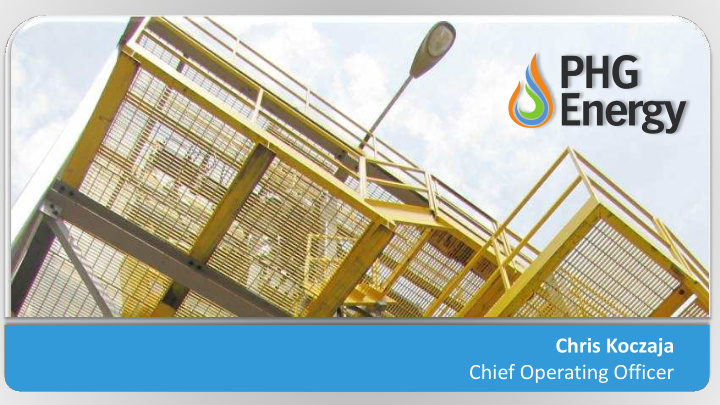



Chris Koczaja Chief Operating Officer
Who is PHG Energy? Since 2007, providing our customers waste-to-energy systems that produce renewable/sustainable power or fuel gas, and cleanly dispose of material that likely otherwise would be landfilled. Owned by a Tennessee family that for over 71 years has provided equipment solutions to the construction, power generation, forestry and agricultural industries. Now a multi-state regional company with 11 offices.
Carbon Clean Crop Emissions Energy Residues Delivering Affordable Renewable Technology Clean Energy Conversion New Landfills Through Gasification Transportation Costs Tipping Fees Sludge Disposal
Waste to Energy Projects City of Covington City of Lebanon Covington, TN Lebanon, TN Sevier Solid Waste Inc. Pigeon Forge, TN
What is Gasification? The clean, efficient conversion of biomass into a combustible fuel gas in an oxygen-starved environment A thermo-chemical process to produce a • clean fuel gas. This is NOT Incineration . Feedstock flexible of the life of the equipment • Can retain and retrofit current equipment to • use the gas (boilers, kilns, etc.) On demand energy generation • About 95% of what goes in comes out as fuel • gas. The other 5% is a charcoal biochar with many uses. Can be adapted for future applications •
Downdraft Gasification Air Evaporate moisture from the feedstock Drying Feedstock breaks down to gas and tars Pyrolysis 3000 degree F oxidation layer cracks tars Oxidation Air Carbon reforms with steam to create Reduction CO and H 2 Rotating Grate shaves biochar layer Grate Residue Residue box for biochar removal
Simple Solutions to Complex Problems
The Flow of Material to Gas Feed Hopper Feed Auger Gasifier Gas Exit Pipes Biochar Collected Quick shutdown and restart up to 24 hours later Few moving parts = simplified maintenance
Flexibility / Expandability PHG-LF PHG-12 (6) X PHG-8 PHG-12 PHG-LF
What Can You “Gasify?” • Woodchips – Utility trimmings – Scrap pallets/Construction – Bark or waste wood – Commercial waste • Agricultural and animal waste • Scrap tires and rubber products • Food processing and other manufacturing waste • Switchgrass, miscanthus and other purpose-grown energy crops • Mixtures improve performance
Feedstock Specifications • Consistent feedstock = consistent gas • Moisture content is key (< 30%) • Feedstock size: ¼” to 4” • Ash content < 10% • Minimum bulk density: 14lbs/ft 3 • Low cost waste streams from other processes can greatly improve economics • Feedstock “Blends” offer further flexibility
Using The Fuel Gas: Currently Being Utilized Here and Worldwide • Electricity: Gas or steam turbines and ORC generators • Steam: Boiler and community heating systems • Direct Thermal: Kiln Operations & Sludge Dryers • Combustion: Industrial thermal oxidizers
Project = Feedstock + Application DRIVING vs. DRIVEN Variables Application Gas to Liquids Combustion Turbine Recip. Engine Lebanon/ Steam Turbine Covington ORC Generator Steam Boral Sevier Solid Brick Waste Inc. Drying Process Heat 80+% ASR 50+% Chicken Litter Tire Feedstock Wood Wood (Dried Biosolids) Pelletized Processed Unprocessed Crop MSW MSW
A Municipal Vision Taking Shape Now Heat and/or Garbage electricity for the process Output Options Municipal Waste Sorter Municipal • Electricity Garbage • Class A biosolids Plastics Metals Pellets Out of Sorter & Glass Application options: Into Gasifier Sorter Removes Recyclables Power Generation Sewer Plant Sludge Drying Pellets Combined Heat and Power ?? Heat Energy Wood Waste Other Waste Provide key TIRES Streams infrastructure to SLUDGE CROPS reduce disposal cost ? risk and volatility
Phase Approach: Use Existing Waste Streams Output Options • Electricity • Class A biosolids Application options: Power Generation Sewer Plant Sludge Drying Combined Heat and Power ?? Heat Energy Wood Waste Other Waste TIRES Streams SLUDGE CROPS PHASE 1: Start with what can be easily handled today ?
Feedstock logistics are KEY Start with a Green Energy wood base and mix other feedstock in Material Collection, Preparation, and Transport Biochar Tipping Fees Biochar Sale
Covington and Lebanon Waste-To-Electricity Systems • Feedstock Flexible System • Energy savings at the WWTP • Revenue streams for tipping fees and biochar • Deferred waste disposal costs
Lebanon Waste to Energy Known Operating Elements: 32 TPD material processed (Expandable to 64TPD) • 3 tons sludge, 3 tons tires, 26 tons wood waste • Operating 24/5/52 or 6240/year • Variable Income Elements and Cash Flow Drivers: Tipping fee income to City from Industry • and/or Wilson County Material hauling and pre-processing costs • Taking existing ATAD offline and • processing sludge in gasifier
System for Sevier Solid Waste Cement Kiln Fuel Wood Gas Combustion / Compost Gasifier Gas Thermal Odor Clean Exhaust Control REDUCE Compost Disposal Cost REDUCE Odor Control Cost REVENUE from the sale of biochar
Keys to a Successful Project Gaining understanding of the waste and energy infrastructure needs and support for a new approach to both o FEEDSTOCK VS. APPLICATION o Tipping fees and hauling costs o Outlet for the energy: heat or electricity or both o Deferred capital expenditures o Biochar market o KEY CONSIDERATIONS o Understanding feedstock preparation and logistics o Managing project complexity o Change management o Work WITH regulators to resolve new issues
Questions? Chris Koczaja Chief Operating Officer 615-290-2425 Chris.Koczaja@phgenergy.com
Recommend
More recommend